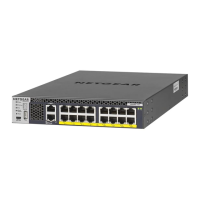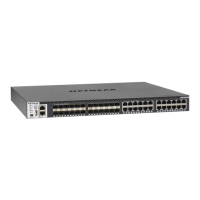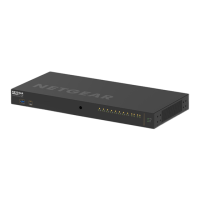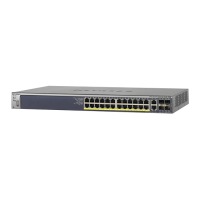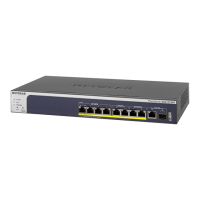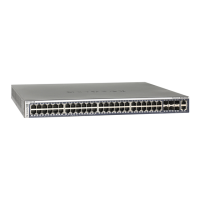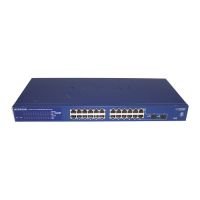Configuration Examples
692
M4300 Series and M4300-96X Fully Managed Switches User Manual
The policy is added.
7. Click the Policy1 hyperlink to view the Policy Class Configuration page for this policy.
8. Configure the Policy attributes as follows:
• Assign Queue: 3
• Policy Attribute: Simple Policy
• Color Mode: Color Blind
• Committed Rate: 1000000 Kbps
• Committed Burst Size: 128 KB
• Confirm Action:
Send
• Violate Action: Drop
For more information about this page, see
Configure DiffServ Policy on page 480.
9. From the Service Configuration page, select the check box next to interfaces g7 and g8 to
attach the policy to these interfaces, and then click the Apply button. (See Configure the
DiffServ Service Interface on page 483.)
All UDP packet flows destined to the 192.12.2.0 network with an IP source address from the
192.12.1.0 network that include a Layer 4 Source port of 4567 and Destination port of 4568
from this switch on ports 7 and 8 are assigned to hardware queue 3.
On this network, traffic from streaming applications uses UDP port 4567 as the source and
4568 as the destination. This real-time traf
fic is time sensitive, so it is assigned to a
high-priority hardware queue. By default, data traffic uses hardware queue 0, which is
designated as a best-effort queue.
Also the confirmed action on this flow is to send the packets with a committed rate of
1000000 Kbps and burst size of 128 KB. Packets that violate the committed rate and burst
size are dropped.
802.1X
Local Area Networks (LANs) are often deployed in environments that permit unauthorized
devices to be physically attached to the LAN infrastructure, or permit unauthorized users to
attempt to access the LAN through equipment already attached. In such environments you
might want to restrict access to the services offered by the LAN to those users and devices
that are permitted to use those services.
Port-based network access control makes use of the physical characteristics of LAN
infrastructures to provide a means of authenticating and authorizing devices attached to a
LAN port that has point-to-point connection characteristics and of preventing access to that
port in cases in which the authentication and authorization process fails. In this context, a port
is a single point of attachment to the LAN, such as ports of MAC bridges and associations
between stations or access points in IEEE 802.1
1 Wireless LANs.
The IEEE 802.1
1 standard describes an architectural framework within which authentication
and consequent actions take place. It also establishes the requirements for a protocol
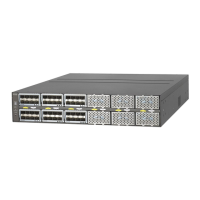
